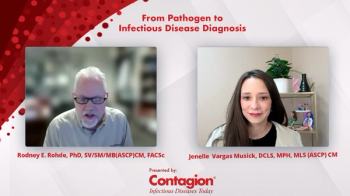
Despite Progress Towards Global Eradication of Polio, Measles, & Rubella, Challenges Remain
In a recent webinar, the CDC and the HHS’s National Vaccine Program Office discussed global efforts being made to eradicate polio, measles, and rubella in the United States.
In a recent
Guthrie Birkhead, MD, MPH, from the NVPO, highlighted the US National Vaccine Plan (NVP), describing it as “the leading roadmap for a 21st century vaccine and immunization enterprise.” It encompasses 5 goals that provide a strategy to improve all aspects of vaccination. One of these goals, he said, is to increase global prevention of death and disease through safe and effective vaccination.
According to John F. Vertefeuille, PhD, MHS, from the CDC, wild polio virus (WPV) type 2 (WPV2) was certified eradicated in 2015, and type 3 WPV (WPV3) has not been detected since November 2012 in Nigeria; only WPV1 remains in circulation today.
The main strategy for polio eradication involves using an oral live attenuated vaccine against all 3 WPV types, he said. In 2016, only 37 cases of polio were reported worldwide, the lowest number in history. In addition, 155 countries were able to remove WPV2 from the oral polio vaccine. “We have seen a 99.9% reduction in polio since 1988,” he emphasized, going from more than 300,000 cases annually in 125 endemic countries, to only 37 cases in 2016 in 3 countries in which polio remains endemic—Afghanistan, Pakistan, and Nigeria.
The main challenge in any eradication program, he stressed, is the need to consider all affected countries at the same time. Despite great progress made so far, the remaining 3 endemic countries present numerous additional challenges in polio eradication. For example, the remaining road toward eradication will require improved access to populations in hard-to-reach areas, he stressed.
According to Gavin Grant, MD, MPH, from CDC, Atlanta, Georgia, elimination of measles and rubella is at an earlier stage than polio is. Measles and rubella activities worldwide are coordinated by the Measles and Rubella Initiative, a collaboration of partners that aims to advance the elimination of these diseases. The Global Measles and Rubella Strategic Plan is a 10-year plan presented by the partners “to achieve and maintain a world without measles, rubella, and congenital rubella syndrome,” by 2020.
To date, increased vaccination efforts have resulted in a significant decline in both measles incidence and deaths from 2000 to 2015. This has translated to a 75% reduction in global measles incidence and a 79% reduction in measles deaths, Dr. Grant said, with an estimated 20.3 million deaths averted.
However, many countries (including those in Africa, Southeast Asia, and Europe) still have significant measles transmission, he added. The rubella elimination program is not as far advanced as the measles program, and some countries with large populations, such as India and Indonesia, only started to introduce rubella vaccine in 2017.
A midterm review of the Global Measles and Rubella Strategic Plan has shown that, despite significant advances in eliminating these diseases, milestones (including elimination of the diseases from some countries by 2020) are not being met.
To address these shortfalls and achieve elimination of measles and rubella, additional efforts are needed, including “increased country ownership and global political will”, Dr. Grant concluded.
The World Health Organization’s Global Measles and Rubella Laboratory Network (GMRLN) provides laboratory support for global measles and rubella surveillance, said Paul Rota, PhD, from CDC, Atlanta, Georgia. In addition to confirming cases of suspected measles or rubella, and measuring population immunity, the GMRLN also identifies genetic relationships of circulating viral strains.
According to Dr. Rota, the GMRLN uses standard protocols for genotyping measles and rubella, and the genotypic data help to monitor the maintenance of eliminating measles and rubella in the United States. Although measles and rubella have been eliminated in the United States, the viruses continue to be introduced from countries in which the diseases remain endemic. In particular, the variety of virus genotypes detected reflects the different sources for the imported viruses, he explained. Using genotypic data helps scientists to “confirm that there is no endemic genotype of measles or rubella,” Dr. Rota emphasized.
Dr. Parry graduated from the University of Liverpool, England in 1997 and is a board-certified veterinary pathologist. After 13 years working in academia, she founded Midwest Veterinary Pathology, LLC where she now works as a private consultant. She is passionate about veterinary education and serves on the Indiana Veterinary Medical Association’s Continuing Education Committee. She regularly writes continuing education articles for veterinary organizations and journals, and has also served on the American College of Veterinary Pathologists’ Examination Committee and Education Committee.
Newsletter
Stay ahead of emerging infectious disease threats with expert insights and breaking research. Subscribe now to get updates delivered straight to your inbox.






















































































































































































































































































































